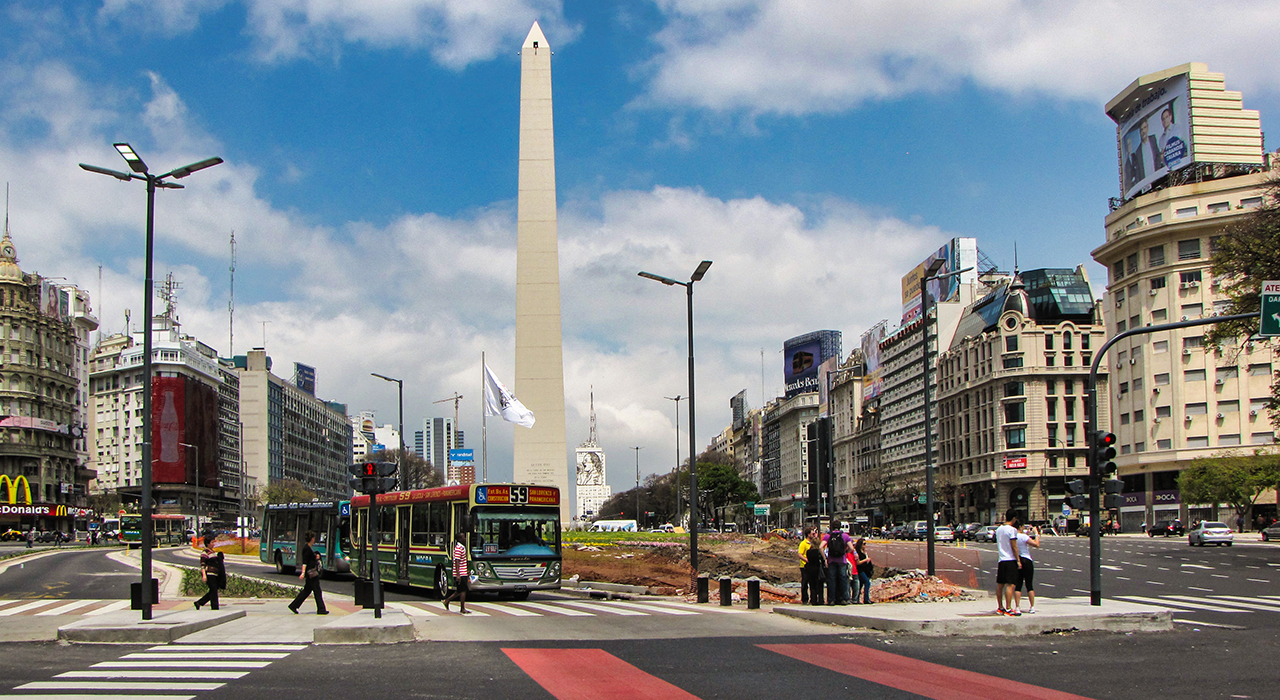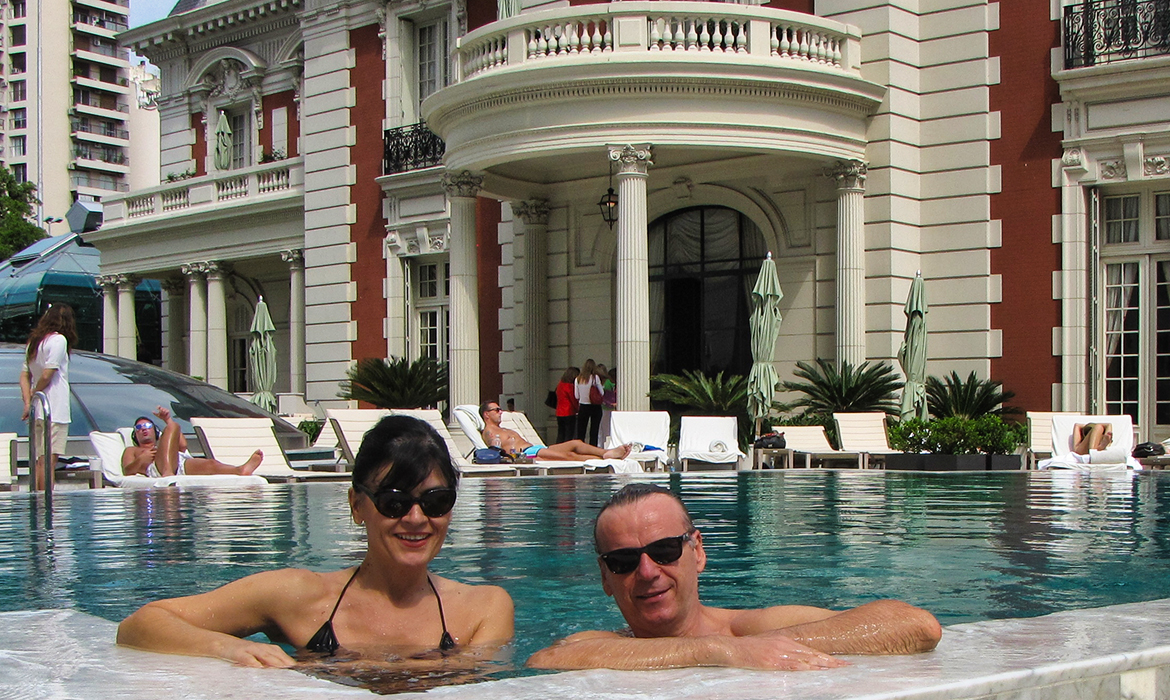


Argentina is famous for its excellent wine and food, as well as music, dance and football. Argentina is home to both the highest and lowest points of the Southern Hemisphere. Down below are more details, but Argentina definitely, deserves a spot on your South America bucket list.
Argentina’s blue and white colors represent the country’s clear blue skies and the Andes’ snow, respectively.
We visited only Buenos Aires and our memories shared on this page are from there.
About Argentina geography
Argentina is a vast country located in the southern part of South America. The eighth largest country in the world, it is the second largest country in South America after Brazil, and it's about one-third the size of the United States. Argentina is bordered by the Andes Mountains and Chile to the west.
To the east of the Andes, the interior of the country is flat, fertile grassland called the Pampas. The eastern border of the country is the Atlantic Ocean. Bolivia is to the northwest and Paraguay is to the north. The high mountain spine of the Andes, called the Andes Cordillera, creates a natural 3,195-mile (5,141.9-kilometer) border with Chile.
The country is divided into four regions: The Andes, the North, the Pampas, and Patagonia. The Pampas is the agricultural heartland.
People and Culture
Unlike Mexico and South American countries such as Peru and Ecuador, Argentina has fewer native people and a large population, which came from Europe. The population is comprised as much as 95% of people of European descent, mostly from Italy, Spain, and Germany. Much of the native population died from diseases brought in by Europeans.
Nearly half of the population lives in the area around Buenos Aires. Buenos Aires has been called the “Paris of South America,” because of the European influences.
The people are well-educated and 97% of the population can read and write.
The Universidad de Buenos Aires (UBA) was founded in 1821 and is the largest institution of higher education in the country, a nation with a 96% literacy rate
Buenos Aires has the most bookstores per person of any city in the world according to a 2015 World Cities Cultural Forum report, with one location for every 4000 citizens
Soccer is the favorite sport in Argentina. British railway workers brought the sport of soccer to Buenos Aires in the mid of 19th century, and since then in Argentina, soccer is almost equal to religion. This year (2023) Argentina won the World Cup in Qatar.
Gauchos, like American cowboys, have been a symbol of the open plains of the Pampas region.
The standard greeting in Argentina is a kiss on one cheek and everybody is kissing everybody almost every time they meet − as long as they know each other. Abandoning to kiss someone in the group is considered very rude. Anyway, it’s good to know.
Nature
Argentina is rich in animal species. The coast of Patagonia is home to elephant seals, fur seals, penguins, and sea lions. The waters off the Atlantic are home to sharks, orcas, dolphins, and salmon.
In the north, there are many large cat species such as the cougar, jaguar, and the ocelot. There are also crocodiles and caiman. Flamingos, toucans, turtles, and tortoises also live in the subtropical north.
Patagonia is a sparsely populated area rich in natural resources and wildlife, including herons, condors, pumas, tortoises, and guanacos.
The highest mountain in the Andes range is the Cerro Aconcagua, which peaks at 22,384 feet (6,960 meters). Northeast Argentina features rain forests and Iguazù Falls. These spectacular falls, on Argentina's border with Brazil, descend along a 1.6-mile (2.7-kilometer) front in a horseshoe shape. As the country develops it is being affected by deforestation and pollution.
History
The Spanish arrived in 1516 and ruled the country for 300 years. In 1806, a British force overpowered Spanish military in Buenos Aires and attacked the Malvinas Islands, also called the Falkland Islands. Local residents recaptured the capital, but never regained control of the islands. These events led to the loosening of Spain's grip on Argentina.
In 1810, Napoleon’s forces conquered all major Spanish cities in Spain and the Argentine people were empowered to take control of their country. They gained independence in 1816.
In 1946, Juan Perón became president due to his popularity with the working class. His wife, Eva, known as Evita, formed a foundation and gave out cash and benefits to the poor. When she died of cancer in 1952, the people were very sad. She was a symbol of hope to all the poor in Argentina. Juan Perón was forced out of office after he tried to increase his powers. Even after he left office, his followers continued to fight for political power.
After many violent years and near civil war, Perón was re-elected president and his new wife, Isabel, became vice president. He died suddenly and Isabel became president and soon the country's economy fell apart. The military took control of the country in 1976, and a period of violence called the “dirty war“ ensued, during which as many as 20,000-30,000 revolutionaries or sympathizers were killed.
In 1982, the president of Argentina, General Leopoldo Galtieri invaded the Falkland Islands off the coast in the Atlantic Ocean thinking the British wouldn’t put up a fight. Galtieri miscalculated and British forces won an easy victory. After the defeat, the country moved toward democracy and civilian rule.
Buenos Aires is a city that never sleeps, famous for its phenomenal nightlife, which ranges from traditional neighbourhood taverns to award-winning cocktail bars, big clubs, hidden gig venues, and underground nightspots catering to every niche.
The most famous landmark of the city and perhaps the symbol of the city is the Obelisco. It was built in 1936 as a monument to the 400th anniversary of the city of Buenos Aires. In 1536 Pedro de Mendoza set foot here in the city. The Obelisco is located in the middle of the widest street with 16 avenues, 9 de Julio. It typically takes at least 2 traffic light rotations to cross.
Buenos Aires is a multicultural city, being home to multiple ethnic and religious groups. Several languages are spoken in the city in addition to Spanish, contributing to its culture and the dialect spoken in the city and in some other parts of the country.
According to a recent study, Buenos Aires’s Spanish sounds more like Neapolitan Italian than any other language including traditional Spanish
Buenos Aires has long had a reputation as one of South America’s most significant centers for art. One of the newest and most impressive galleries is the Latin American Art Museum of Buenos Aires (MALBA). Housed in a superb modern building resembling a number of interlocking cubes, this world-class museum has numerous works by modern artists from across Latin America and serves as a cultural center showcasing the country’s film and visual arts.
The city’s most interesting outdoor sculpture, Floralis Genérica, is a massive steel and aluminum flower in the midst of Plaza de las Naciones Unidas that even closes at night and emanates a pleasing red glow.

Puente de la Mujeres bridge represents a couple dancing tango, with the white mast symbolising the man and the curve of the bridge, the woman. It has a large turning mechanism, allowing it to swing open to allow sailing ships to pass. The bridge was constructed in Spain and donated to Buenos Aires through a private donation.
It’s located in the Dock 3 of the Puerto Madero commercial district of Buenos Aires,

A passion for tango: Full of sensuality and nostalgia, tango is part of Buenos Aires’ identity.
Forged through a fusion of European, African and native Argentine influences, tango is a music and couple dance that developed in Buenos Aires’ working class immigrant neighbourhoods in the mid-19th century.
Today Buenos Aires remains the world capital of tango and is awash with professional stage shows, musical performances, tango schools, tango-themed cafes and hotels, and, of course, milongas, traditional social gatherings to which amateur dancers return night after night in search of the perfect embrace.
At closing, we have to mention the Four seasons hotel in Buenos Aires. Set in the exclusive Recoleta neighbourhood, Four Seasons is a combination of an early-20th-century mansion and a contemporary high-rise, offering the best of modern comfort with European-style glamour. Thank you for watching...
